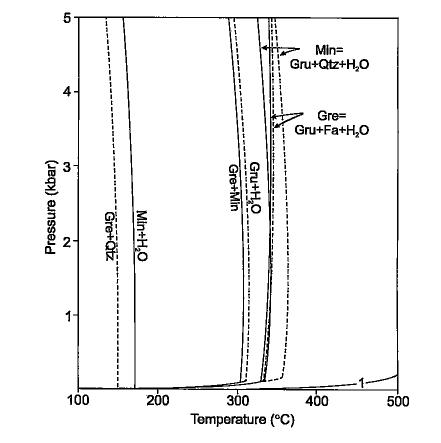Localities
The Sokoman Formation in the Howells River area, at the western edge of the Labrador Trough, in Canada, is a sedimentary formation in which early diagenetic features are overprinted by later ones which are the result of very low-grade metamorphic reactions. Of the three iron silicates, greenalite, stilpnomelane and minnesotaite, greenalite appears to be of very early origin (sedimentary to diagenetic). Stilpnomelane appears to be diagenetic origin, and minnesotaite is generally considered to be of very low-grade metamorphic origin. The minerals which make up this silicate-rich iron-formation are, in approximate decreasing order of abundance, greenalite, stilpnomelane, minnesotaite, magnetite, chert (or quartz), carbonates (members of the dolomite-ankerite series, siderite and calcite) and locally small amounts of riebeckite (CM 12.475-498).
At the type locality, Biwabik, Mesabi Range, St. Louis county, Minnesota, USA, greenalite occurs as a primary mineral. The Biwabik iron-bearing formation is the largest of the Lake Superior iron formations, consisting largely of chert. The next most abundant constituents are greenalite, siderite and iron oxides. Greenalite is characteristically associated with slate layers (AM 20.405-425).
Greenalite from Biwabik - Image
At the Overlook Mine, Cooke Mountain, Belcher Mining District, Ferry county, Washington, USA, a fayalite-bearing assemblage of iron silicates, magnetite and pyrrhotite, plus quartz and calcite, formed during alteration of a volcanogenic, carbonate-rich, massive magnetite- seafloor deposit. Greenalite and minnesotaite are present, but no grunerite has been found. The paragenetic sequence fayalite to greenalite to minnesotaite to quartz represents infiltration at approximately 300oC of an initially very reducing, iron-rich hydrothermal fluid (CM 36.147-162).
Alteration
The PT diagram on the right is for the system FeO-SiO2-H2 at low temperatures. Abbreviations Gre greenalite,
Min minnesotaite, Gru grunerite, Fa fayalite and Qtz quartz
(CM 36.157).

fayalite, SiO2 and H2O to greenalite
3Fe2+2SiO4 + SiO2 aqueous + 4H2O → 2Fe3Si2O5(OH)4
(CM 36.157).
greenalite to grunerite, fayalite and H2O
9Fe3Si2O5(OH)4 → Fe2+2Fe2+5Si8O22(OH)2 + 10Fe2+2SiO4 + 17H2O
(CM 36.157).
greenalite and SiO2 to minnesotaite and H2O
Fe3Si2O5(OH)4 + 2SiO2 → Fe2+3Si4O10(OH)2 + H2O
(CM 36.157).
greenalite and minnesotaite to grunerite and H2O
2Fe3Si2O5(OH)4 + 5Fe2+3Si4O10(OH)2 → 3Fe2+2Fe2+5Si8O22(OH)2 + 6H2O
(CM 36.157).
Mg-rich greenalite to olivine, SiO2 and H2O
2(Fe2+, Mg)3Si2O5(OH)4 → 3(Fe,Mg)2SiO4 + SiO2 + 4H2O
(DHZ 1A p265)
Mg-rich greenalite to olivine, Mg-rich grunerite and H2O
18(Fe2+, Mg)3Si2O5(OH)4 → 20(Fe,Mg)2SiO4 + 2(Fe2+,Mg)7Si8O22(OH)2 + 34H2O
(DHZ 1A p266)
Back to Minerals